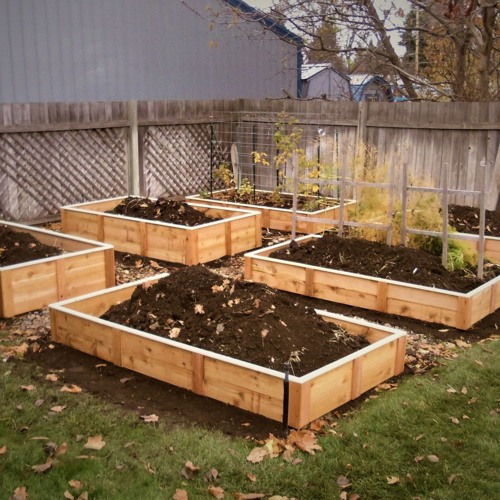Preparing your Garden Beds for Spring Planting
Published: January 26, 2021

With the holidays behind us and a new year upon us the next thing for us to look forward is the warmer weather and if you're like us you're probably counting down the days. When it comes to your raised garden bed the hardest part is making sure it is well prepared for the season. Let's look at some ways for you to prepare your raised beds for a good growing season.
Don't Tread on Thee
One of the most important things to adhere to is do not walk on the soil in your raised beds. The biggest benefit of having a raised garden bed is the light fluffy well-drained soil that allows vigorous plant growth. Stepping on the soil compacts it and reduces aeration which slows the activity of the microorganisms that live beneath the surface.
Turn your Covers
Turn any cover crops that you may have planted in the fall before they go to seed to provide a nitrogen rich fertilizer back into the soil. Depending on what type of cover crops you planted at the end of last season. Some cover crops can just be covered with mulch and plastic sheeting to smother them, while others will need to be trimmed down to stubble and possibly turning them in the soil with a hoe. If you don't wish to disturb the soil you can sow your new crops next to the stubble and allow the new crops to break down the stubbled cover crops.
Check your Beds
This is the time when you want to inspect your beds for anything issues that may require attention. Most beds show issues in the corners when the extra wet soil gets to be too heavy, or if your bed spans a good length it may start to bow out in the middle. If your bed is starting to bow out in the middle this can be remedied by either affixing a stake on the inside of this section and screwing it into said span or running aluminum flat stock across the bed affixing it to the sides.
Clear the Weeds
To make sure you have a good harvest this season you will want to remove any weeds or invasive roots that have started to pop up around your garden bed. Look for fast growing roots from weeds and pull them in the direction in which they came. Look for tree roots that are creeping towards your beds, they tend to be attracted to moist fertile soil. Some people like to lay down a weed block underneath their beds, we tend to stray from doing this as it can negatively impact root growth.
Add Amendments
The soil in your raised bed is constantly settling, for example come spring your solid level may be lower than it was in the fall. If you're not using the no till method on your beds, take a spade full of dirt and see if it moist and crumbly. If the soil is compacted you can till in some peat to help fluff it up.
Cover the Soil
Covering your soil is a good thing to do throughout the year but it is especially, but is especially useful in the early spring after your amendments and any fertilizer has been added to help retain warmth which in turn helps your amendments break down before seeds are planted or plants are transplanted.
Time to Plant
Once the soil temperature reaches a steady 60 degrees F to start sowing your seeds into the beds for optimum germination, don't get excited at the first warm spell and plant early. At this point if you haven't already done so it is a good time to place your stakes, poles or trellises for any taller or vine crops.
Build your new Custom and get a Free Instant Quote Today
Our state of the art designers allow you to design and build completely customized to fit your exact needs.
Questions or concerns contact us here or via 412.641.0177 .
Build an Instant QuoteNeed Help?
Contact Us @ 412.641.0177
Recently Published
Interior Cabinet Door Styles That Elevate Your Kitchen Or Bathroom
Published: November 12, 2025
Why Mortise
Published: October 23, 2025
From Shaker To Raised Panel: Cabinet Door Styles That Transform Your Home
Published: October 08, 2025
How To Match Door
Published: September 30, 2025
Choosing The Right Exterior Shutters: Louvered, Board
Published: September 25, 2025
The Warmth Of Wood: Barn Doors Tailored To Your Home
Published: September 09, 2025
Classic Style, Modern Strength: Custom Wooden French Doors
Published: September 03, 2025
Built By Hand, Designed To Last: Custom Wood Louvered Doors
Published: July 07, 2025
Flat Panel Shutters For Colonial, Craftsman, And Farmhouse Styles
Published: May 28, 2025
Bring Old-World Charm Home With Custom Wooden Louvered Shutters
Published: May 04, 2025

